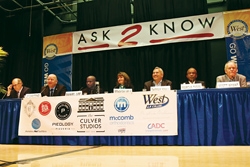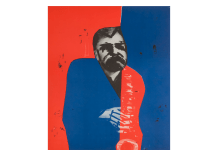Several things set the Ask 2 Know series of forums apart from other candidate panels that occur at election time: all the questions are asked by Culver City kids and teens, the moderators are kids, and “lightening round” questions connect Culver City to key larger issues being debated in the nation.
For example, in the March 2 forum for Culver City City Council, one lightening round question was, “Would you support a Planned Parenthood clinic opening in Culver City?” Jay Garacochea answered that he did not take a “strong stance” on the issue and it should be left to the community; all other candidates were very strong supporters of a hypothetical Planned Parenthood in Culver City. Ask 2 Know is independently produced and focuses on the entire community, as opposed to the many neighborhood forums that address issues pertinent to a particular area.
The Ask 2 Know forum was founded by independent producer and creative visionary Michelle Mayans. This was the third forum held at West Los Angeles College. All seven candidates were present: Göran Eriksson, Jay Garacochea, Daniel Lee, incumbent Meghan Sahli-Wells, Thomas Small, Marcus Tiggs, and Scott Wyant. There are two open seats and Sahli-Wells is running for reelection to her second term.
In addition to the “lightening rounds” in which each candidate gave a 30-second response, individual candidates were queried by students in the audience. At the conclusion of each round of questioning, each candidate then had the opportunity to choose one question asked of their colleagues to respond to in depth.
The majority of student questions were workshopped with Genevieve Gilbert-Rolfe, chair of the Culver City High School Social Studies Department. The questions covered almost every topic of import to the Culver City resident, from the risk to local drinking water from nearby fracking to the dangers of underground natural gas storage, from the high cost of housing to the increased frequency of low-altitude flights. The introduction of body cameras in the Culver City Police Department was another national topic also delved into at the forum. Topics more pertinent to youth were also brought up, such as teen employment, recreational facilities, and traffic around Culver City High School.
Ten percent of the largest oil field in the Western U.S. lies in Culver City; the other 90 percent is part of Los Angeles. Hydraulic fracturing or “fracking” does occur in this oil field. Sahli-Wells, the only incumbent in the race, said the city council had been working on strict regulations to cover fracking in the Culver City-portion of the oil field, had asked Gov. Jerry Brown to ban fracking, and she expressed her own vision for eventually turning the land into one of the largest parks in the area. She highlighted the goal of closing the Culver City portion of the oil field as one step to making Culver City a model in terms of alternative energy usage.
Lee thought that fracking should be banned outright and candidate Small encouraged Culver City to turn away from “old energy models” such as fossil fuels. Wyant noted that the oil field “was almost entirely in the county of Los Angeles” and that while it was “an inherently dirty and unsafe” business, the council could “push it away from Culver City” as far as possible, creating a “buffer” zone.
This writer was surprised to find out, in the course of this forum, that there is a natural gas storage facility similar to that in Porter Ranch in Playa Vista, a few miles west of Culver City. Porter Ranch recently experienced the largest methane leak in U.S. history, forcing people to relocate for months while the leaking gas well was repaired. Both Wyant and Eriksson expressed the urgent need for a survey of the Playa Vista gas storage facility to ensure a leak such as in Porter Ranch does not occur in Culver City’s neighbor Playa Vista. Eriksson specifically noted that the two facilities share the same type of well castings, except that Playa Vista’s are 20 years older than those found in Porter Ranch.
Both home prices and rents have increased dramatically over the past five years, making it difficult for some long-time residents to afford to stay in the community, and pricing homes out of the reach of many first-time buyers. While this is often thought of as a problem faced by adults, one student at the forum asked if candidates would consider rent control as a way to help families stay in the city they have known for many years. Only Tiggs and Eriksson had the opportunity to respond. Tiggs said he opposed rent control, but advocated reforming the city’s current landlord-tenant mediation board to have “greater teeth” and take into account issues beyond rental payment. Eriksson said every economic study to look at the issue of rent control has found it to be ineffective, and the answer instead is to increase the supply of housing. Similarly, in response to one of the opening questions of the forum, “What would you like to change in Culver City?” Wyant answered that he would like to see “more and smaller houses” so that people are able to afford to live in Culver City as well as work here.
The increasing frequency of low-altitude flights over Culver City has been of concern to a broad base of residents, with advocacy groups and protests formed in response. Wyant affirmed his commitment to suing the FAA after the release of their Environmental Impact Report (cities have 60 days from the release of EIR to file suit), while Eriksson suggested joining a nationwide coalition of cities and pushing the FAA to adopt rules used to Europe that allow for a steeper descent, thereby allowing planes to remain at a higher altitude for much longer periods of time, reducing noise and pollution for those on the ground.
Referencing a year of increased awareness of police misconduct, one student asked the candidates if they supported body cameras for officers in the Culver City Police Department. Sahli-Wells recalled that at the 2012 Ask 2 Know forum a similar question was asked about installing police car dash-cams and she relayed that dash-cams had been installed in every police car, and that the city council had already released funds for every CCPD officer to have a body camera. She also said that the police department was in favor of body cameras. Small also voiced his support for body cameras. Lee noted that while body-cams were important, they were not the answer to police brutality or misconduct because in controversial circumstances footage can be lost, and the real answer lies in “citizen oversight” and changing “the culture of policing.”
A common theme addressed by several students’ questions was the need for youth and community activities that are affordable, fun, and accessible, such as indoor gym facilities with basketball courts, a bowling alley, city-sponsored movies and concerts in parks across Culver City (not only in downtown), and the implementation of a First Friday program modeled on Abbot Kinney’s popular monthly street food and music festival. Eriksson was the only candidate to have a chance to respond to the request for indoor recreational centers; he suggested a partnership between the city, school district, and private businesses would be a way to create such facilities considering the city’s limited budget. Sahli-Wells noted that she was instrumental in bringing Ciclavia, the free event where streets close to car traffic and are open to bicycles, scooters, and skateboards, to Culver City and said she expected it to be a annual spring festival.
Beginning a First Friday program in Culver City was a popular idea among the candidates. Garacochea said that while starting First Fridays was a “great idea,” he needed time to find an ideal spot for such an event to be held. Wyant was very enthusiastic about the idea and stated he would work on it “his first day in office” and that he’d “love to come to one.” Lee said that since Main Street is already closed Tuesday afternoons for the Farmers’ Market, he thought that would be a good location, and he supported the city backing First Fridays.
Michelle Mayans founded the Ask 2 Know series of forums in 2010 to give young community members a voice in local elections. Since then, Ask 2 Know has sponsored six City Council and School Board forums in Culver City. Mayans says of her goals, “I try to encourage civic engagement in our youth and adults alike. I also try to point out that what happens in other parts of the country, such as in Flint, Michigan and Porter Ranch, could happen here.”














